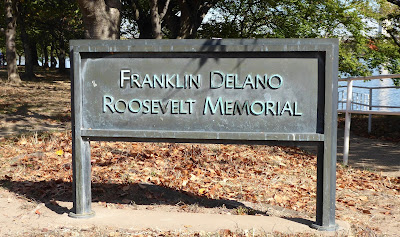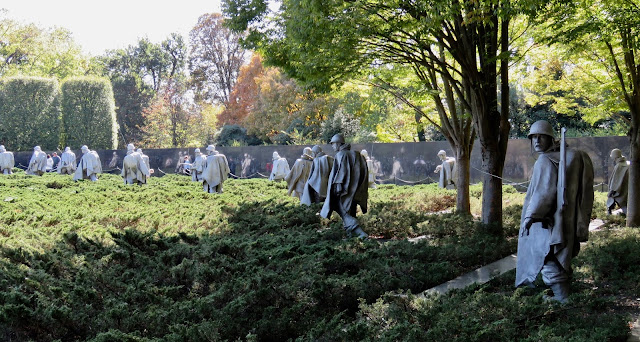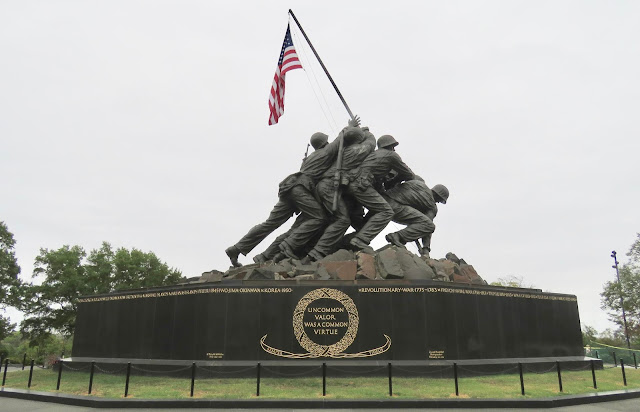Carol writes: As the calendar page flipped over to October, our long and winding road to the mid-Atlantic coast reached its most eastward point in Maryland, just outside of Washington, D.C. Here, we planned to pause for a month to take in the history and sights while reflecting on the many ways our travels have enriched our understanding of what it means to be an American. We cannot imagine a more fitting place than our nation’s capital to conclude our nearly 5-year adventure across the highways and back roads of America.
We set up camp in a deluxe campground in College Park, Maryland.
This campground had its own bus stop from which a dedicated bus made dozens of trips daily to the College Park Metro station. Once we got our first taste of “insane DC traffic,” the Metro rapid transit system turned out to be the perfect means of travel, since almost every city venue we wanted to visit was reachable by Metro.
The monuments and memorials of Washington, D.C., are perhaps the city’s most beloved treasures. The ones dedicated to four of our greatest presidents are among the most famous in the world.
During our last visit to Washington, D.C., the Washington Monument was covered in scaffolding and was undergoing repairs to cracks that had developed as a result of an earthquake in August 2011. This time, the stonework of this 500-ft spire dedicated to our first president was gleaming brilliantly in the midday sun.
Now, the Jefferson Memorial was the one covered in scaffolding while complex repairs are being made to its dome. Under the dome inside, Jefferson’s silent, larger than life-size statue evoked volumes of wisdom.
The dignified Lincoln Memorial towered over the western end of the Reflecting Pool on the National Mall.
The memorial’s 36 grand Doric columns symbolized the states that were in the Union at the time of Lincoln’s death.
Inside, our beloved 16th president was seated on a grand chair of power and authority, while exhibiting a tense and somber facial expression directed at all the visitors below taking irreverent selfies at his feet. At this particular memorial, I found the selfie craze distasteful. In light of our visit to Gettysburg only a few weeks ago, silent thanks and respect seemed much more appropriate.
One of the more unique and less visited memorials in Washington is the Franklin Delano Roosevelt Memorial. This sprawling memorial consisted of 4 outdoor “rooms” said to represent Roosevelt’s four terms in office. Shapes of “rooms” were formed by blocks of granite inscribed with memorable FDR quotes.
The bronze statue of the former president featured a seated Roosevelt along with his beloved dog, Fala. In this 4th term “room,” the president’s face was clearly exhausted and he appeared to be in poor health.
was included in the memorial to honor her much admired service to our country.
The greatness of America was clearly illustrated at every turn along the Mall. Likewise, the long redress of America’s greatest failing—enslavement of its African American population—was brilliantly acknowledged at the Martin Luther King, Jr. Memorial. The “out of the mountain of despair, a stone of hope” symbolism from Dr. King’s famous “I have a dream” speech was a bold design.
The pathway chiseled through the stone mountain to the rear of the statue was symbolic of the difficult struggles in the fight for equal rights, opportunity, and justice.
This memorial was an excellent place to reflect on both the good and the bad chapters in the American story. The immense stone statue of Dr. King emerging from a granite block of stone overlooked the Tidal Basin cherry trees that should be in bloom every year on the anniversary of his death.
The war memorials along the National Mall are among the most somber remembrances. The Vietnam War is still fresh in the minds of baby boomers, and many of them have family and friends who made the supreme sacrifice. The black granite Vietnam Wall, set into a low hillside and carved with the names of all who perished or are missing in action, represents a superb interpretation of that war.
The diverse group of three young soldiers on patrol, looking on in tribute toward the names on the wall in the distance, emphasizes the poignancy of the sacrifice…
The platoon on patrol at the Korean War Veterans Memorial captured the unspeakable torment of this conflict perfectly.
The newest monument on the Mall, the World War II Memorial, opened in 2004. This memorial is dedicated to all who served in the armed forces and as civilians in World War II. The design of the memorial comprises a semicircle of 56 pillars, one for each state and US possession that served in the war. Triumphal arches for the Pacific and Atlantic theaters of war anchor opposite ends with sensational fountains in the middle, with waters glistening under brilliant blue skies.
Monuments dedicated to three branches of our military were especially emotional for us. At the United States Air Force Memorial, our hearts swelled with pride with thoughts of our daughter in the Air Force, who is currently in service to our country.
Three giant steel spires appeared to soar into the sky, representing contrails from the familiar “bomb burst” maneuver performed by the Thunderbirds, the demonstration precision flying team of the Air Force. Over many years we observed this Thunderbird maneuver on Air Force Academy graduation day at our former home in Colorado Springs.
The bronze statues of the Air Force Honor Guard stood unmoving and silent with honor and respect for all who serve or have served in the United States Air Force.
The Iwo Jima Memorial is dedicated to all Marine personnel who have died in service to our country. This mammoth bronze sculpture group depicts the moment a large flag was raised on Mount Suribachi during the Battle of Iwo Jima.
The action and drama of the moment is quite inspirational…
And finally, the statue of The Lone Sailor has obvious special significance for the Galus family. Al served 20 years as an officer in the Navy after graduating from the United States Naval Academy in 1969, and we have come to the Washington, D.C. area to attend his 50th class reunion this week.
The statue of The Lone Sailor also reminds us of this picture of our son, Jason, which was taken in 2004 when he was serving as an Army officer and came to Washington, D.C., to run a race as a member of the Army team. He is standing next to The Lone Sailor, much like his father above.
He had a friend take the picture because he knew how much it would mean to his dad. The sweetness of his message at the side of The Lone Sailor will always mean the world to both of us…
For now... here are my thoughts on looking back, with lines interspersed from the poem “Pity the Nation” written by Lawrence Ferlinghetti..
The monuments and memorials of Washington, D.C., have reinforced many lessons we have learned at all the presidential sites we have visited throughout our travels. So many of our presidents were great spotlights in history who shined brightest when our nation needed them most, sometimes while serving as president and in other instances post presidency. Almost every president (with a few notable exceptions) possessed many admirable character traits—truthfulness, inspiring leadership, devotion to country over self, firmly held convictions, and the ability to unite us as a nation. We discovered that those presidents who have fallen short of these character traits are HELD ACCOUNTABLE IN THE PAGES OF HISTORY.
"Pity the nation whose leaders are liars, whose sages are silenced, and whose bigots haunt the airwaves."
The war memorials along the National Mall hit home the fact that war is an awful chisel to carve out the future.
“Pity the nation—oh, pity the people who allow their rights to erode and their freedoms to be washed away.”
And personally, we were once again reminded that the monuments to branches of our military will always pull at our heartstrings…
“My country, tears of thee, sweet land of liberty.”
Carol Galus
Photo-Blogger



























Wow! Great Blog & Amazing Serving. If you want to Service of Scaffolding then just visit here Scaffolding in Sevenoaks.
ReplyDelete